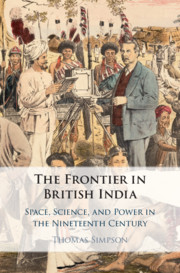Introduction
Published online by Cambridge University Press: 07 January 2021
Summary
British power at India’s northwest and northeast frontiers was only occasionally predicated on categorising and codifying, emanating more often from indeterminacy and upheaval. These were spaces of productive difficulties for colonial administrators, who prized as well as feared the supposed unruliness of uplands and deserts at the state’s fringes. This chapter provides a theoretical outline of how India’s frontiers became spaces of scientific and governmental exception, situating the book’s core arguments in relation to scholarship on power, knowledge, territory, and borderlands. It proposes that although internally fragmented by social structures, terrain, and colonial categories, colonial India’s frontiers took shape through ideational and material connections and comparisons. Following increasingly intense interventions from the later 1860s, by the turn of the twentieth century frontiers were established as crucial spaces of imperial power, science, and self-fashioning.
- Type
- Chapter
- Information
- The Frontier in British IndiaSpace, Science, and Power in the Nineteenth Century, pp. 1 - 20Publisher: Cambridge University PressPrint publication year: 2021
- 1
- Cited by

